Designers present ideas for Court Buildings
Court rulings in a high tower, in a pit, or in the cloud: if it were up to the three interdisciplinary creative design teams the court of the future has little in common with the courts of today.

Since there is already much change occurring within the judicial processes of the courts themselves, implementation of information technology and the new role for judges, it becomes imperative that the physical structure of court buildings are also adapted and adjusted to meet current legal developments.
GRAS, a platform for architecture and city development, has been working with experts from the justice field at HiiL Innovating Justice on a design manifestation with the aim to give impetus for the court buildings of the future. Three interdisciplinary teams of architects, designers, landscape developers, and interior designers have collaboratively researched with judicial experts to outline the global innovations awaiting courts, and how said designs can create and facilitate this new manner of functioning
The teams conducted their research at, among other places, the International Criminal Court and the newly built court in Amsterdam, and were able to gain knowledge of experts in the field by attending lectures and discussions. Their designs were presented on December 11th at the Innovating Justice Forum, in which 150 justice leaders, law reformers, and judicial specialists from around the world have gathered in The Hague to discuss the innovation of law and justice.
Laura Kistemaker, of HiiL: “A meeting between creative design and judicial professionals is very rare, and the physical representation of the future of the court is just a great addition to the existing, verbal and written, discussions about changing procedures.”
Team 1 presented their interpretation of a court of last resort. “People find themselves here if it has truly escaped them to form an alternative solution to their legal problem,” states the ByBali architects-team. “The building reaches out to people by literally and figuratively being its own poster board. Making the court building more visible to the community is an interesting theme: can you develop a courthouse that immediately shows what is meant to take place while setting an example in which fewer lawsuits are needed?” Also part of team1 are Daniël Leenders (6to9design), Eelco Hoeke (In.Vorm.Eel.com) and Sahar Khan.
Team 2 designed a courthouse in which clarity concerning judicial questions is central to the legal process. “For us, it is not a question of whether or not we are moving towards a digital legal system, but when and in what form”, according to team member Rozemarijn Koopmans and David de Zwart of Multitude. Teammate Jan-Richard Kikkert of K2 architects: “Our goal is the reinvent the legal system and to give everyone who has access to the internet control over their own rights, through the use of an open-data cloud.” There is therefore no physical building, only a digital approach.
The 3rd team focussed upon courts that aim to help people solve their problems. “We imagine a large glass greenhouse, open to the public, located at the site of the current Ministry of Foreign Affairs, which will soon need a new function,” states architect Judith Schotanus. Team member Elsbeth Ronner adds: “All the courtrooms and public spaces are designed to stimulate social interaction and dialogue. We also provide judges with the possibility to influence the physical space according to the needs of a case. For example, a judge will have the ability to make a room smaller in order to put pressure on the parties to reach an agreement.” Melvin Kaersenhout, Laura Vellinga and Ashley Bennett are also members of this team.
The visitors of the Innovating Justice Forum were enthusiastic about the designs of the three teams. “It’s very mind expanding to see how ideas we talk about could become actual structures. I feel this changes and helps my thinking”, said a visitor. The designs were also food for debate. A judge noted on the digital approach: “I am far less optimistic about access to reliable internet, especially outside the cities.” A researcher responded on twitter: “Homo-digitalis is coming, and the court of the future had better be ready for it.”
The manifest has been made possible by a generous contribution of the Creative Industries Fund NL. The results of the of the three teams will be integrated into the Trend Report entitled Trialogue- releasing the value of courts, which will be made available this month.